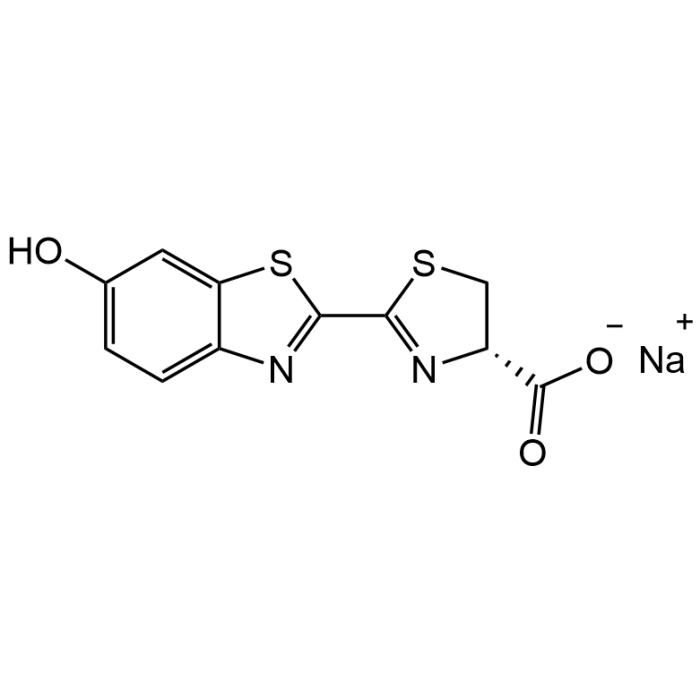Cookie Policy: This site uses cookies to improve your experience. You can find out more about our use of cookies in our Privacy Policy. By continuing to browse this site you agree to our use of cookies.
Chemodex
D-Luciferin sodium salt
As low as
39
CHF
CHF 39.00
In stock
Only %1 left
CDX-L0008-M05050 mgCHF 39.00
CDX-L0008-M250250 mgCHF 155.00

| Product Details | |
|---|---|
| Synonyms | D-(-)-Luciferin sodium salt; Firefly luciferin sodium salt; BrightGlo sodium salt; (S)-2-(6-Hydroxy-2-benzothiazolyl)-2-thiazoline-4-carboxylic acid sodium salt, 4,5-Dihydro-2-(6-hydroxy-2-benzothiazolyl)-4-thiazolecarboxylic acid sodium salt |
| Product Type | Chemical |
| Properties | |
| Formula | C11H7N2NaO3S2 |
| MW | 302.3 |
| CAS | 103404-75-7 |
| Source/Host Chemicals | Synthetic |
| Purity Chemicals | ≥98% (HPLC) |
| Appearance | Faint to dark yellow powder. |
| Solubility | Soluble in water, PBS (pH7.2), DMSO or DMF (all 10 mg/ml). |
| Identity | Determined by 1H-NMR. |
| Declaration | Manufactured by Chemodex. |
| Other Product Data |
Click here for Original Manufacturer Product Datasheet |
| InChi Key | LILQLBIQROYWIA-OGFXRTJISA-M |
| Smiles | O=C([O-])[C@H]1CSC(C(S2)=NC3=C2C=C(O)C=C3)=N1.[Na+] |
| Shipping and Handling | |
| Shipping | AMBIENT |
| Short Term Storage | +4°C |
| Long Term Storage | -20°C |
| Handling Advice |
Protect from light and moisture. Very light-sensitive. |
| Use/Stability | Stable for at least 2 years after receipt when stored at -20°C. |
| Documents | |
| Product Specification Sheet | |
| Datasheet |
 Download PDF Download PDF |
Description
D-Luciferin sodium salt is a water-soluble format of D-Luciferin. D-Luciferin is the most popular and versatile bioluminescent substrate. The firefly luciferase/luciferin bioluminescent system is found in the firefly (Photinus pyralis) and several other beetles. Firefly luciferase produces light by the ATP-dependent oxidation of D-Luciferin. The 560nm chemiluminescence from this reaction peaks within seconds, with light output that is proportional to luciferase activity when D-Luciferin and ATP are present in excess. Luciferase is encoded by the luc gene, which is widely used as a reporter gene in a variety of cells. Because of the intrinsic low background of chemiluminescence technique, detection of the luc gene expression can be made at very low level. In addition, luciferin/luciferase has been used to measure 10-15 molar quantity of ATP. D-luciferin and luciferase can be used to assess ATP availability in cellular or biochemical assays. Firefly luciferase has long been conjugated to antibodies and used as a label in immunoassays using D-Luciferin as the substrate for detection. Compared to HRP and alkaline phosphatase, luciferase is less tolerant to chemical modifications. One particular advantage to the enzyme is that there is low endogenous luciferase activity in mammalian tissues besides its high sensitivity. Another important use of luciferase is in the area of hygiene monitoring. The luciferase/luciferin system can be used to detect contamination because ATP, present in all living organisms, is required to produce luminescence. The main application for this type of ATP bioluminescence is quality assurance by testing surfacesin food processing plants to determine whether or not there iscontamination of eitherequipment or products.
Product References
(1) A.R. Brasier, et al.; Biotechniques 7, 1116 (1989) | (2) W.J. Simpson, et al.; Lett. Appl. Microbiol. 1, 208 (1990) | (3) N. Lembert, et al.; Biochem. J. 317, 273 (1996) | (4) D.R. Lasko & D.I. Wang; Biotechnol. Bioeng. 52, 364 (1996) | (5) F. Brau, et al.; BBRC 270, 247 (2000) | (6) W. Wang & W.S. El-Deiry; Cancer Biol. Ther. 2, 196 (2003) | (7) K. Niwa, et al.; FEBS Lett. 580, 5283 (2006) | (8) Y. Inoue, et al.; Eur. J. Nucl. Med. Mol. Imaging 36, 771 (2009) | (9) S.T. Smale; Cold Spring Harb. Protoc. 2010, pdb.prot5421 (2010) | (10) Y.Q. Sun, et al.; Angew. Chem. Int. Ed. Engl. 51, 8428 (2012) | (11) S.T. Adams & S.C. Miller; Curr. Opin. Chem. Biol. 21, 112 (2014) (Review)





